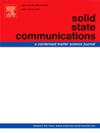非晶Tb1-xAux合金的自旋波和随机磁各向异性研究
IF 2.1
4区 物理与天体物理
Q3 PHYSICS, CONDENSED MATTER
引用次数: 0
摘要
研究了金(Au)对x = 20、25、30和33 at的非晶合金Tb1−xAux箔磁性能的影响。%被检查。在0.5 t的外加磁场下,在4.2 ~ 250 K的温度范围内进行了磁测量,发现居里温度(TC)随着(Tb)被(Au)取代而降低。通过将布洛赫定律应用于磁化的温度依赖性分析,我们成功地提取了几个关键参数,如自旋波刚度常数(D)和交换常数(A)。我们进一步探索了系统饱和磁化的方法,并通过随机磁各向异性模型来解释这些发现。这种深刻的分析使我们能够揭示几个基本参数。当x值从0.20增加到0.30时,局部磁各向异性常数KL从2.30 × 107 erg/cm3显著增加,峰值为9.1 × 107 erg/cm3。然而,当x = 0.33时,我们注意到KL减小,达到3.28 × 107 erg/cm3。本文章由计算机程序翻译,如有差异,请以英文原文为准。
Spin-wave and random magnetic anisotropy studies in amorphous Tb1-xAux alloys
The influence of gold (Au) on the magnetic properties of amorphous alloy Tb1−xAux foils with compositions of x = 20, 25, 30 and 33 at.% is examined. Magnetic measurements were conducted over a temperature range of 4.2–250 K under an external applied field of 0.5 T. It was observed that the Curie temperature (TC) decreases with the substitution of (Tb) by (Au). By applying Bloch's law to the analysis of the temperature dependence of magnetization, we successfully extracted several crucial parameters, such as the spin wave stiffness constant (D) and the exchange constant (A). The approach to saturation magnetization in the system was further explored, with the findings interpreted through the lens of the random magnetic anisotropy model. This insightful analysis enabled us to unveil several fundamental parameters. It was discovered that the local magnetic anisotropy constant KL increases significantly, rising from 2.30 × 107 erg/cm3 to a peak of a 9.1 × 107 erg/cm3 as the x value increases from 0.20 to 0.30. However, for x = 0.33 we notice that KL decreases, reaching 3.28 × 107 erg/cm3.
求助全文
通过发布文献求助,成功后即可免费获取论文全文。
去求助
来源期刊

Solid State Communications
物理-物理:凝聚态物理
CiteScore
3.40
自引率
4.80%
发文量
287
审稿时长
51 days
期刊介绍:
Solid State Communications is an international medium for the publication of short communications and original research articles on significant developments in condensed matter science, giving scientists immediate access to important, recently completed work. The journal publishes original experimental and theoretical research on the physical and chemical properties of solids and other condensed systems and also on their preparation. The submission of manuscripts reporting research on the basic physics of materials science and devices, as well as of state-of-the-art microstructures and nanostructures, is encouraged.
A coherent quantitative treatment emphasizing new physics is expected rather than a simple accumulation of experimental data. Consistent with these aims, the short communications should be kept concise and short, usually not longer than six printed pages. The number of figures and tables should also be kept to a minimum. Solid State Communications now also welcomes original research articles without length restrictions.
The Fast-Track section of Solid State Communications is the venue for very rapid publication of short communications on significant developments in condensed matter science. The goal is to offer the broad condensed matter community quick and immediate access to publish recently completed papers in research areas that are rapidly evolving and in which there are developments with great potential impact.
 求助内容:
求助内容: 应助结果提醒方式:
应助结果提醒方式:


